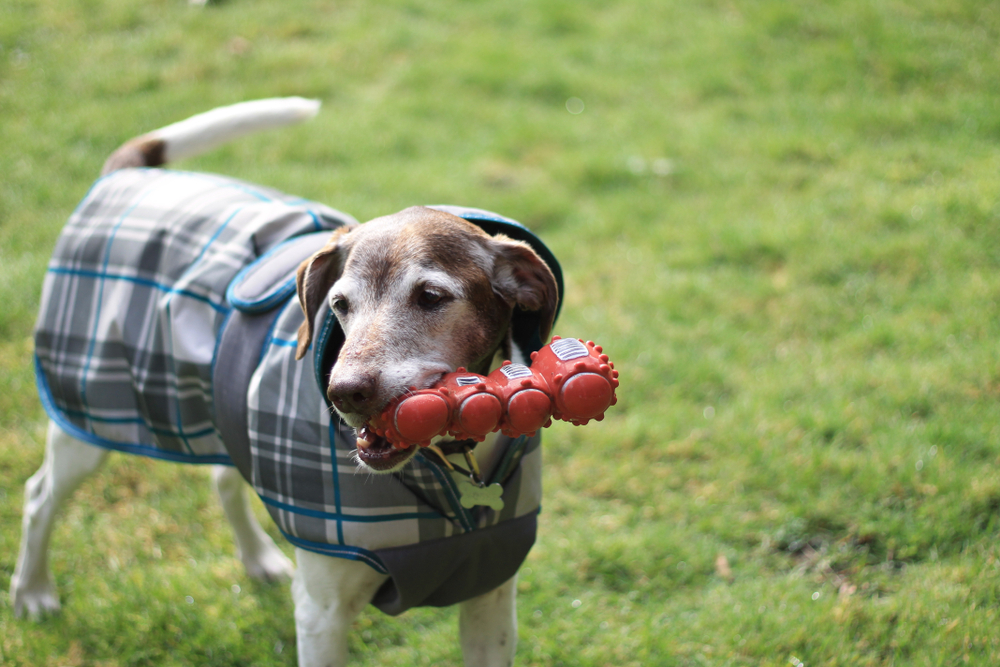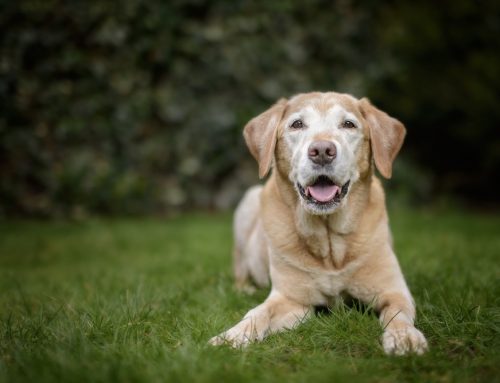Many dog owners struggle to accept that their once active and agile canine companion has become a senior citizen. In the blink of an eye, their muzzle turns grey, their eyes cloud, and their once fluid movements stiffen and slow. Conditions such as arthritis, intervertebral disc disease, cataracts, cognitive dysfunction, and sensory loss affect their daily lives, causing pain and stealing their confidence. However, altering your home to accommodate your senior dog’s age-related changes can help them maintain their independence and quality of life.
#1: Textured floors help your senior dog get a grip
If your senior dog is avoiding certain areas in your home, they may be worried about slick floors. As dogs age, they lose body awareness and strength in their large stabilizer muscles (i.e., core muscles), which affect balance and control. If your senior dog has slipped or fallen on tile, hardwood, or concrete, they may feel they cannot travel freely through the home.
Help your senior pet return to their usual routine and regain confident movement by placing non-slip rugs over slippery areas. If you prefer not to have a “rug-runway” cutting through your decor, consider a product your dog can wear to improve their grip, such as PawFriction or ToeGrips.
#2: Improve your senior dog’s accessibility with ramps
Arthritis and hip dysplasia can turn your senior dog’s previously powerful back legs to thin and wobbly supports incapable of jumping. Similarly, decreased visual depth perception, elbow dysplasia, and neck pain can make landing scary, painful, and dangerous.
Provide easy access to and from your senior pet’s favorite elevated spots (e.g., couch, bed, car, or short flight of stairs) by installing pet ramps. Look for an appropriate ramp that matches the following criteria:
- Textured surface (e.g., foam mat, artificial turf, or treads)
- Lightweight
- Appropriate size to ensure a gentle slope
- Folds in half, or telescopes for easy transport
Senior dogs certainly can learn new tricks, such as how to navigate a ramp. Use treats and praise to introduce the ramp slowly on the ground, and then at a low height. Body harnesses, such as the Help ’Em Up or Ruffwear WebMaster, can provide additional support for large dogs.
#3: Ensure your senior dog has access to the facilities
Pain, disorientation, and multiple medical conditions may cause your senior dog to have urinary or fecal accidents. If they begin to eliminate inappropriately, schedule a medical assessment at Star of Texas Veterinary Hospital to rule out any manageable conditions, such as urinary tract infection, early renal failure, diabetes, or a weakened urinary sphincter.
Give your aging pet ample opportunities to eliminate in the appropriate area, such as setting a timer on your phone to take them outside more often. Additional changes can include:
- Replacing stairs with ramps, when possible
- Confinement to a smaller area near the door
- Providing potty pads
- Sticking to a consistent feeding schedule
- Cleaning all messes with an enzymatic cleaner to prevent re-soiling
#4: Raise food and water dishes to eliminate senior pet pain
When senior dogs lower their head to eat or drink, their weight shifts forward, applying pressure to their neck, shoulders, and elbows, and causing pain and balance loss. Elevate your dog’s dishes with a raised feeder, or place them on a stair or box to create a more natural angle.
#5: Provide your senior pet with sweet dreams in a supportive bed
Sleep is vital for mental and physical health. An appropriate bed can make a tremendous difference in your senior dog’s sleep quality and their waking hours, which will improve your ability to successfully care for them.
Senior dog beds should be made from orthopedic foam, to provide consistent joint support. Avoid plush beds that sink in, or are enclosed by high sides, as your dog may struggle to rise or climb out. Waterproof bedding is a necessity if your senior dog is having accidents.
#6: Downsize your senior dog’s habitat
Changes in vision or cognition can cause your senior dog to become frightened, disoriented, or lost in their once familiar surroundings. If your dog is wandering, going to the wrong side of a door, or failing to recognize familiar faces, have them examined at Star of Texas Veterinary Hospital, and senior-proof their living space:
- Use baby gates or closed doors, to restrict their ability to wander and roam.
- Place resources, such as food, water, toys, potty pads, and bed, in a consistent location, for easy and reliable access.
- Avoid rearranging or adding furniture, to prevent confusion.
- Place rugs on slippery floors, to prevent injury.
- Restrict access to stairs.
Your senior pet’s new area should be centrally located in your home, to prevent isolation and depression.
#7: Spend quality time with your senior dog

Your senior dog may prefer sleeping over walking or playing, but don’t overlook their need for attention and affection. Dogs, like people, can become depressed from isolation and lack of engagement, so make an effort to ensure your best friend remains part of the family.
The shared bond between you and your senior dog is built on a lifetime of trust. As their world changes, your senior dog will look to you for continued care and comfort. Be there for them by providing veterinary care at Star of Texas Veterinary Hospital, and keeping them safe, confident, and comfortable at home. Contact us, to schedule an appointment for your senior dog.






